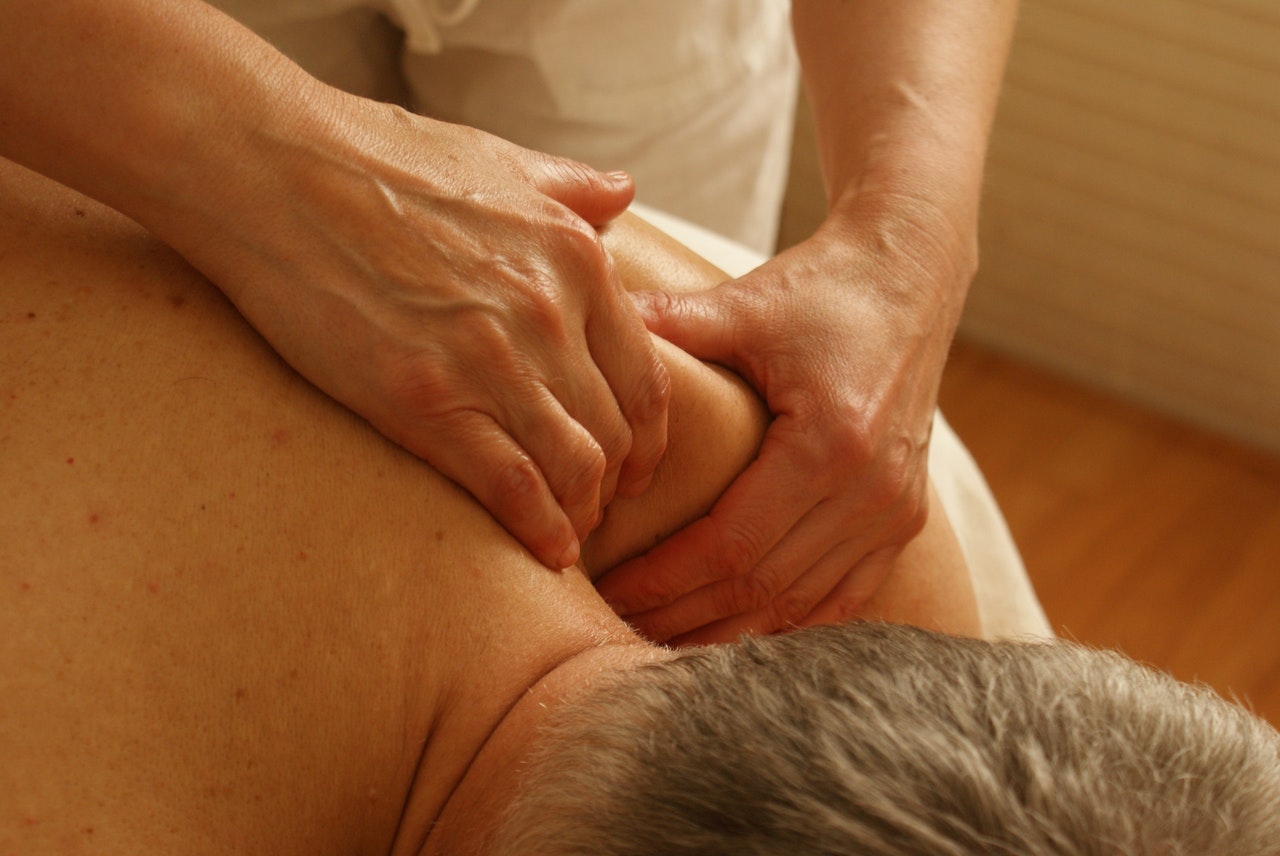Four Science Backed Ways Massage Makes You Feel Better
/My current goal is to promote the value of massage therapy by synthesizing and simplifying noteworthy finds and best available supporting evidence applicable to massage therapy.
Four Science Backed Ways Massage Makes You Feel Better
The responses to massage therapy are multifactorial - physiological and psychological factors interplay in a complex manner. The biopsychosocial model provides a practical framework for investigating the complex interplay between massage therapy and clinical outcomes.
Based off the biopsychosocial model, investigation into mechanisms of action should extend beyond local tissue changes and include peripheral and central endogenous pain modulation. An observed favorable outcome may be explained by a number of overlapping mechanism in the periphery, spinal cord, and brain represented in the image below.
Proposed Therapeutic Mechanisms of Massage
More to Explore
Best, T. M., & Crawford, S. K. (2017). Massage and postexercise recovery: The science is emerging. British Journal of Sports Medicine.
https://www.ncbi.nlm.nih.gov/pubmed/27797730
Best, T.M., Gharaibeh, B., Huard, J. (2013). Stem cells, angiogenesis and muscle healing: a potential role in massage therapies? Br J Sports Med.
https://www.ncbi.nlm.nih.gov/pubmed/23197410
Bialosky, J.E., Beneciuk, J.M., Bishop, M.D., ... George, S.Z. (2018). Unraveling the Mechanisms of Manual Therapy: Modeling an Approach. J Orthop Sports Phys Ther.
https://www.ncbi.nlm.nih.gov/pubmed/29034802
Bove, G.M., Chapelle, S.L., Hanlon, K.E., Diamond, M.P., Mokler, D.J. (2017). Attenuation of postoperative adhesions using a modeled manual therapy. PLoS One. (OPEN ACCESS)
https://www.ncbi.nlm.nih.gov/pubmed/28574997/
Bove, G.M., Harris, M.Y., Zhao, H., Barbe, M.F. (2016). Manual therapy as an effective treatment for fibrosis in a rat model of upper extremity overuse injury. J Neurol Sci. (OPEN ACCESS)
https://www.ncbi.nlm.nih.gov/pubmed/26810536
Boudier-Revéret, M., Gilbert, K.K., Sobczak, S. (2017). Effect of neurodynamic mobilization on fluid dispersion in median nerve at the level of the carpal tunnel: A cadaveric study. Musculoskelet Sci Pract.
https://www.ncbi.nlm.nih.gov/pubmed/28734168
Chen, L., Michalsen, A. (2017). Management of chronic pain using complementary and integrative medicine. BMJ.
https://www.ncbi.nlm.nih.gov/pubmed/28438745
Chimenti, R.L., Frey-Law, L.A., Sluka, K.A. (2018). A Mechanism-Based Approach to Physical Therapist Management of Pain. Phys Ther.
https://www.ncbi.nlm.nih.gov/pubmed/29669091/
Courtney, C.A., Fernández-de-Las-Peñas, C., Bond, S. (2017). Mechanisms of chronic pain - key considerations for appropriate physical therapy management. J Man Manip Ther.
https://www.ncbi.nlm.nih.gov/pubmed/28694674
Crane, J.D., Ogborn, D.I., ... Tarnopolsky, M.A. (2012). Massage therapy attenuates inflammatory signaling after exercise-induced muscle damage. Sci Transl Med. https://www.ncbi.nlm.nih.gov/pubmed/22301554
Ellingsen, D., Leknes, S., Løseth, G., Wessberg, J., & Olausson, H. (2016). The Neurobiology Shaping Affective Touch: Expectation, Motivation, and Meaning in the Multisensory Context. Frontiers in Psychology. (OPEN ACCESS)
https://www.ncbi.nlm.nih.gov/pubmed/26779092
Habig, K., Schänzer, A., Schirner, W., ... Krämer, H.H. (2017). Low threshold unmyelinated mechanoafferents can modulate pain. BMC Neurol. (OPEN ACCESS)
https://www.ncbi.nlm.nih.gov/pubmed/28915853
Lloyd, D.M., McGlone, F.P., Yosipovitch, G. (2015). Somatosensory pleasure circuit: from skin to brain and back. Exp Dermatol.
https://www.ncbi.nlm.nih.gov/pubmed/25607755
Louw, A., Nijs, J., Puentedura, E. (2017). A clinical perspective on a pain neuroscience education approach to manual therapy. Journal of Manual & Manipulative Therapy.
https://www.ncbi.nlm.nih.gov/pubmed/28694679
Mancini, F., Beaumont, A., Hu, L., Haggard, P., & Iannetti, G. D. (2015). Touch inhibits subcortical and cortical nociceptive responses. Pain. (OPEN ACCESS)
https://www.ncbi.nlm.nih.gov/pubmed/26058037
Melzack, R. & Wall, P.D. (1965). Pain mechanisms: a new theory. Science.
http://www.ncbi.nlm.nih.gov/pubmed/5320816
Miller, B.F., Hamilton, K.L., ... Butterfield, T.A., Dupont-Versteegden, E.E. (2018). Enhanced skeletal muscle regrowth and remodelling in massaged and contralateral non-massaged hind limb. J Physiol.
https://www.ncbi.nlm.nih.gov/pubmed/29090454
Morikawa, Y., Takamoto, K., Nishimaru, H., ... Nishijo, H. (2017). Compression at Myofascial Trigger Point on Chronic Neck Pain Provides Pain Relief through the Prefrontal Cortex and Autonomic Nervous System: A Pilot Study. Front Neurosci. (OPEN ACCESS)
https://www.ncbi.nlm.nih.gov/pubmed/28442987
Newell, D., Lothe, L.R., Raven, T.J. (2017). Contextually Aided Recovery (CARe): a scientific theory for innate healing. Chiropr Man Therap. (OPEN ACCESS)
https://www.ncbi.nlm.nih.gov/pubmed/28289539
Nummenmaa, L., Tuominen, L., Dunbar, R., ... Sams, M. (2016). Social touch modulates endogenous μ-opioid system activity in humans. Neuroimage.
https://www.ncbi.nlm.nih.gov/pubmed/27238727
Rabey, M., Hall, T., Hebron, C., Palsson, T.S., Christensen, S.W., Moloney, N. (2017). Reconceptualising manual therapy skills in contemporary practice. Musculoskeletal Science and Practice.
https://www.ncbi.nlm.nih.gov/pubmed/28286240
Rapaport, M.H., Schettler, P., Larson, E.R., ... Kinkead, B. (2016). Acute Swedish Massage Monotherapy Successfully Remediates Symptoms of Generalized Anxiety Disorder: A Proof-of-Concept, Randomized Controlled Study. J Clin Psychiatry.
https://www.ncbi.nlm.nih.gov/pubmed/27464321/
Rossettini, G., Carlino, E., Testa, M. (2018). Clinical relevance of contextual factors as triggers of placebo and nocebo effects in musculoskeletal pain. BMC Musculoskelet Disord. (OPEN ACCESS)
https://www.ncbi.nlm.nih.gov/pubmed/29357856
Thompson, W. R., Scott, A., Loghmani, M. T., Ward, S. R., & Warden, S. J. (2016). Understanding Mechanobiology: Physical Therapists as a Force in Mechanotherapy and Musculoskeletal Regenerative Rehabilitation. Physical Therapy. (OPEN ACCESS)
https://www.ncbi.nlm.nih.gov/pubmed/26637643
Vigotsky, A. D., & Bruhns, R. P. (2015). The Role of Descending Modulation in Manual Therapy and Its Analgesic Implications. Pain Research and Treatment. (OPEN ACCESS)
https://www.ncbi.nlm.nih.gov/pubmed/26788367
Walker, S.C., Trotter, P.D., Swaney, W.T., Marshall, A., Mcglone, F.P. (2017). C-tactile afferents: Cutaneous mediators of oxytocin release during affiliative tactile interactions? Neuropeptides.
https://www.ncbi.nlm.nih.gov/pubmed/28162847
Waters-Banker, C., Dupont-Versteegden, E. E., Kitzman, P. H., & Butterfield, T. A. (2014). Investigating the Mechanisms of Massage Efficacy: The Role of Mechanical Immunomodulation. Journal of Athletic Training. (Open Access)
https://www.ncbi.nlm.nih.gov/pubmed/24641083
Zhu, G.C., Tsai, K.L., Chen, Y.W., Hung, C.H. (2018). Neural Mobilization Attenuates Mechanical Allodynia and Decreases Proinflammatory Cytokine Concentrations in Rats With Painful Diabetic Neuropathy. Phys Ther.
https://www.ncbi.nlm.nih.gov/pubmed/29309710


